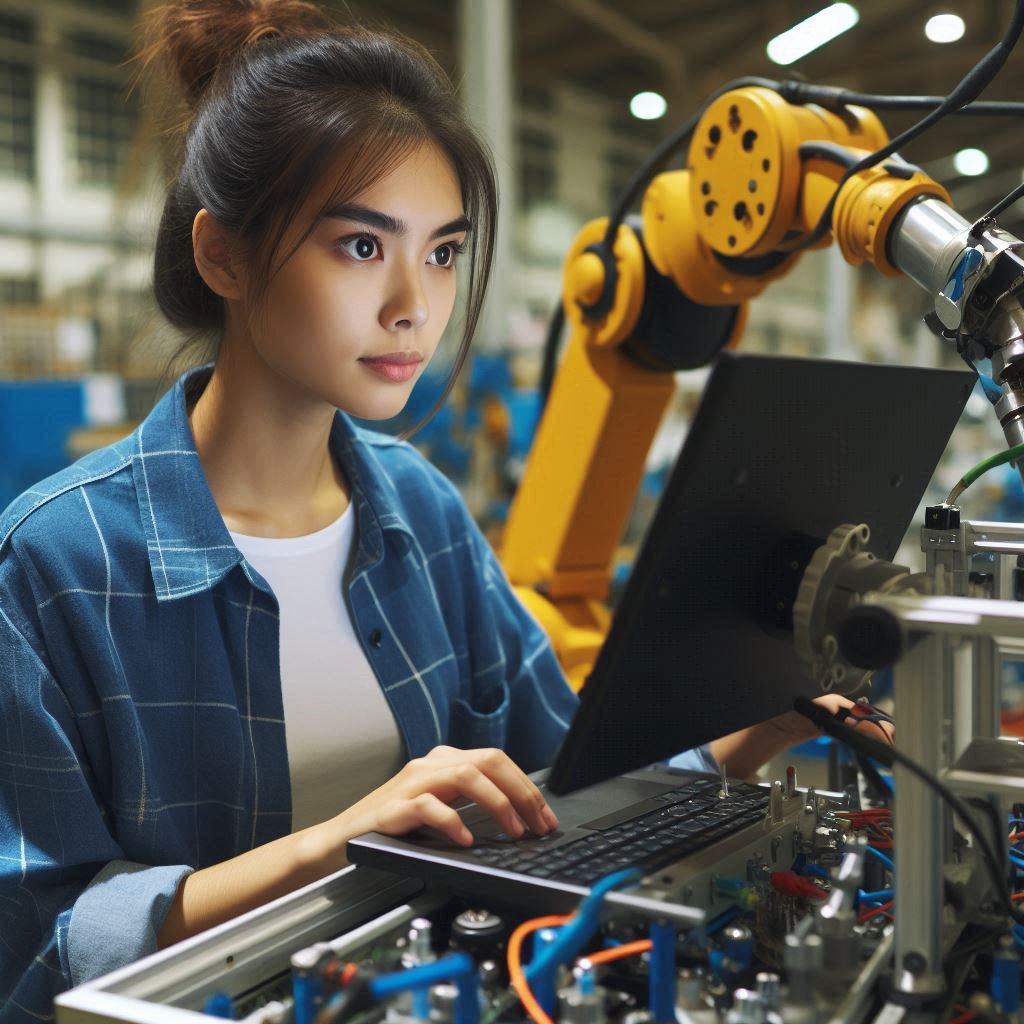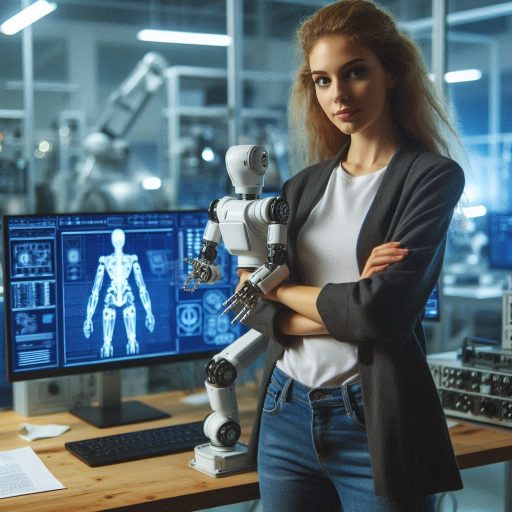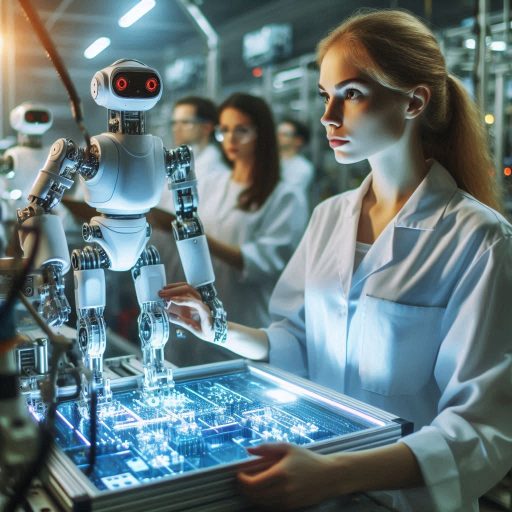Introduction
Robotics is making significant strides across numerous industries in the USA, fundamentally transforming the way businesses operate.
In manufacturing, robotics drives automation, increasing production rates and ensuring consistent quality.
Advanced robotic systems now handle complex tasks in assembly lines, from precise welding to intricate component assembly.
In healthcare, robots assist in surgeries with unmatched precision, enhance patient care through automated systems, and streamline administrative tasks.
The impact of robotics extends beyond these sectors.
In agriculture, robots improve efficiency in planting and harvesting.
In logistics, they optimize warehouse management and distribution processes.
The presence of robotics in these industries is a testament to its growing importance and versatility.
However, this rapid integration of robotics presents both positive and negative consequences.
On the positive side, robotics enhances operational efficiency, reduces human error, and performs repetitive or hazardous tasks, thereby increasing overall productivity.
Robots can operate 24/7 without fatigue, leading to significant cost savings and operational improvements.
In healthcare, robotic assistance often results in more accurate surgeries and faster recovery times for patients.
Healthcare Industry
Robotics technology is transforming patient care and treatment outcomes, offering precision, efficiency, and improved safety in healthcare settings.
From robotic surgical systems to advanced medical devices, robots are enhancing the quality of care and streamlining medical procedures.
Improving Patient Care and Treatment Outcomes
Robotic technology enhances surgical precision, leading to less invasive procedures and faster recovery times.
Robots can perform intricate maneuvers with greater accuracy than human hands, minimizing the risk of complications and improving surgical outcomes.
This precision is particularly beneficial in delicate surgeries, such as neurosurgery or minimally invasive procedures.
Additionally, robotic systems assist in rehabilitation, offering tailored physical therapy programs and improving patient mobility.
Examples of Robotic Systems and Medical Devices
Several robotic systems and devices are making a significant impact in hospitals:
- da Vinci Surgical System: This system allows surgeons to perform complex procedures through tiny incisions using robotic arms controlled by a console.
- RoboDoc: Used in orthopedic surgeries, RoboDoc assists in precisely aligning implants, improving the accuracy of joint replacements.
- CyberKnife: This robotic system targets cancer cells with precise radiation therapy. It minimizes damage to surrounding tissues, offering a non-invasive alternative to surgery.
- Rehabilitation Robots: Devices like the Lokomat help patients with mobility issues by providing robotic-assisted gait training, aiding in their recovery process.
Potential Job Displacement
Despite these advancements, the rise of robotics in healthcare raises concerns about job displacement among healthcare workers.
Automated systems and robotic-assisted procedures can reduce the demand for certain manual tasks performed by medical staff.
For example, robotic surgical systems may decrease the need for surgical assistants and traditional technicians.
As robots take on more tasks, healthcare workers might face challenges in adapting to new roles or undergoing retraining to work alongside robotic systems.
Automation drives the need for upskilling and professional development.
Healthcare workers must stay relevant and manage advanced robotic systems.
Balancing the integration of robotics with the workforce’s needs is essential.
Robots improve patient care and treatment outcomes.
Healthcare institutions must actively support and retrain their staff to adapt to these changes.
Robots enhance patient care and treatment outcomes.
Healthcare institutions must support and retrain staff to adapt to these changes.
Read: Top Companies Hiring CAD Technicians in the USA
Manufacturing Industry
Increased Efficiency and Productivity
The integration of robotics into the manufacturing industry has revolutionized production processes, leading to significant increases in efficiency and productivity.
In automotive plants, robots handle tasks like welding, assembly, and painting with high precision and speed.
This automation reduces production times and enhances overall product quality.
Similarly, electronics factories use robots for intricate tasks such as circuit board assembly and component placement.
The continuous, error-free operation of robots has allowed these industries to scale production while maintaining consistent quality.
Examples of Automation
Automotive plants and electronics factories serve as prime examples of the benefits of automation in manufacturing.
In automotive production, robots are instrumental in streamlining processes, reducing costs, and minimizing errors.
Electronics factories have also embraced automation, using robots to handle delicate tasks that require precision and consistency.
These examples highlight how robotics can optimize production and contribute to industry growth.
Concerns About Job Loss
Despite the clear advantages, the rise of robotics in manufacturing raises concerns about job displacement.
As robots assume tasks previously performed by humans, many workers face the risk of losing their jobs.
The shift has prompted discussions about the future of manufacturing jobs and the need for proactive solutions.
Retraining for Displaced Workers
To mitigate the impact of job loss due to automation, it is crucial to invest in retraining programs for displaced workers.
These programs can help workers develop new skills that align with the evolving demands of the industry.
By providing opportunities for reskilling, the workforce can transition into new roles that emerge as automation continues to advance.
Ensuring that workers are supported through this transition is essential for maintaining a balanced and sustainable manufacturing industry.
While robotics has undoubtedly enhanced efficiency and productivity in manufacturing, the human impact must also be considered.
The industry must balance the benefits of automation with strategies to support workers, ensuring a smooth transition into this new era of manufacturing.
Read: Best Online Courses for CAD Technician Training
Agriculture Industry
The Rise of Robotics in Crop Monitoring, Harvesting, and Livestock Management
The agriculture industry is undergoing a transformative shift with the increasing use of robotics in various farming processes.
Robots are now integral to crop monitoring, harvesting, and livestock management.
In crop monitoring, drones and ground-based robots equipped with sensors and cameras provide real-time data on plant health, soil conditions, and pest activity.
This enables farmers to make informed decisions about irrigation, fertilization, and pest control, ultimately improving crop yields.
Harvesting robots, designed to pick fruits and vegetables with precision, reduce the reliance on manual labor and increase efficiency.
Livestock management has also seen advancements with robotic systems that monitor animal health, automate feeding, and even assist with milking.
These innovations are revolutionizing how farms operate, leading to increased productivity and reduced labor costs.
The Benefits of Precision Agriculture
Precision agriculture, powered by robotics and advanced technology, offers substantial benefits to the agriculture industry.
By using data-driven insights and automated machinery, precision agriculture allows farmers to optimize resource use, resulting in significant cost savings.
For example, automated irrigation systems can deliver water precisely where and when it is needed, reducing water waste and lowering costs.
Similarly, targeted application of fertilizers and pesticides minimizes the amount of chemicals used, reducing environmental impact and enhancing sustainability.
These practices not only save money but also contribute to the long-term health of the environment by conserving resources and reducing pollution.
Additionally, precision agriculture improves crop yields by ensuring that plants receive the right amount of nutrients and care.
This level of control and efficiency is key to meeting the growing global demand for food while minimizing the agricultural sector’s ecological footprint.
Impact on Traditional Farming Practices and Rural Communities
While the adoption of robotics and precision agriculture offers numerous benefits, it also poses challenges for traditional farming practices and rural communities.
The shift towards automation may lead to the displacement of workers who have traditionally relied on manual labor in farming.
This can have significant social and economic implications, particularly in rural areas where agriculture is a primary source of employment.
The high cost of acquiring and maintaining robotic systems may prevent small-scale farmers from using them.
This could widen the gap between large agribusinesses and family-run farms.
Traditional farming methods, passed down through generations, may also be at risk of becoming obsolete as technology takes center stage.
However, these challenges also present opportunities for growth and adaptation.
Farmers who embrace technology can enhance their productivity and sustainability, ensuring their farms remain competitive in a rapidly evolving industry.
Government and agricultural organizations can support rural communities by offering training programs and financial incentives.
These initiatives help communities transition to new technologies while preserving traditional farming practices.
Read: How to Build a Strong CAD Technician Portfolio

Retail Industry
In the retail industry, the implementation of robotic systems has revolutionized
Implementation of Robotic Systems in Warehouses
The retail industry is rapidly adopting robotic systems to revolutionize warehouse operations.
Robots are increasingly used for tasks such as picking, packing, and sorting products, significantly speeding up order fulfillment.
These systems enhance efficiency by reducing human error and increasing processing speeds.
Automation handles repetitive tasks, allowing warehouses to operate with greater precision and lower costs.
This leads to quicker delivery times and improved customer satisfaction.
Integration of AI in Customer Service and Inventory Management
AI technology is becoming integral to retail operations, particularly in customer service and inventory management.
AI-powered chatbots and virtual assistants offer immediate customer support, manage inquiries, and track orders.
They enhance the overall shopping experience.
In inventory management, AI systems analyze sales data and predict stock levels, optimizing inventory to meet customer demand and minimize overstock.
This integration not only improves operational efficiency but also helps retailers make data-driven decisions.
Effects of Automation on Retail Jobs and the Changing Retail Landscape
The rise of automation is reshaping the retail job market and altering the retail landscape.
As robots and AI systems take over repetitive and manual tasks, some traditional retail roles are being displaced.
However, this shift also creates new job opportunities in areas such as robotics maintenance, AI programming, and system management.
The retail environment is evolving with automation driving the need for skills in technology and data analysis.
While automation brings efficiency and cost savings, it also challenges the workforce to adapt to new roles and develop skills aligned with technological advancements.
Transform Your Career Today
Unlock a personalized career strategy that drives real results. Get tailored advice and a roadmap designed just for you.
Start NowRead: Future of CAD Technician Jobs in Engineering
You Might Also Like: How to Secure Internships in Mining Engineering
You Might Also Like: Networking Tips for Aerospace Engineers
Transportation Industry
As technology continues to advance, the transportation industry is not left behind in integrating robotics into its operations.
Below are some key points outlining the impact of robotics on the transportation sector in the USA:
Growth of Autonomous Vehicles
- Autonomous vehicles are becoming increasingly popular in the transportation industry for both public transportation and freight delivery.
- Self-driving cars and trucks are being developed to streamline transportation processes and improve overall efficiency.
- Autonomous drones are also being used for deliveries in some parts of the country, further advancing automation in the industry.
Safety Concerns and Regulations
- Despite the benefits of autonomous vehicles, safety concerns remain a top priority for regulators and industry stakeholders.
- Robotic technology must meet stringent safety standards and regulations to ensure the well-being of passengers, drivers, and pedestrians.
- Issues such as cybersecurity, human error, and system malfunctions need to be addressed to prevent accidents and ensure public trust.
Potential Impact on Jobs
- With the increasing automation of transportation processes, there is a growing concern about the impact on jobs in the sector.
- While robotic technology can improve efficiency and reduce costs, it may also lead to job displacement for workers in traditional roles.
- There is a need for workforce reskilling and upskilling to adapt to the changing landscape of the transportation industry.
In fact, robotics revolutionizes the transportation industry in the USA.
Autonomous vehicles are growing rapidly.
Safety concerns and job impacts are key focuses.
As technology evolves, stakeholders must collaborate to address challenges.
This teamwork ensures a smooth transition to a more automated future.
Uncover the Details: Environmental Engineering Internship Opportunities
Construction Industry
Robotics and automation have been making significant inroads into the construction industry in the USA.
From robotic construction equipment to 3D printing technology, these innovations have revolutionized how buildings are designed and constructed.
One of the key benefits of using robotics in the construction industry is the efficiency gains it brings to building processes.
Robots are capable of working around the clock without fatigue, leading to faster construction timelines and reduced labor costs.
Advancements in Robotic Construction Equipment
Robotic construction equipment, such as autonomous vehicles and drones, are being used to perform tasks that were previously done manually.
These robots can navigate construction sites, carry heavy materials, and even assist in building structures.
For example, drones equipped with cameras can survey a construction site and provide real-time data to project managers.
This enables them to monitor progress, identify potential issues, and make informed decisions to ensure the project stays on track.
3D Printing Technology
Another major advancement in the construction industry is the use of 3D printing technology to create building components on-site.
This technology allows for the rapid production of complex and customized parts, resulting in faster construction times and reduced waste.
Companies like ICON use 3D printing to build affordable housing solutions.
This technology addresses housing shortages and affordability issues in the USA.
Efficiency Gains in Building Design and Construction Processes
Integrating robotics and automation into building design and construction enhances precision, consistency, and quality.
Companies achieve better results with these technologies.
This leads to the creation of more innovative and sustainable structures that meet the demands of modern society.
Robots can handle repetitive and labor-intensive tasks with ease, freeing up human workers to focus on more complex and creative aspects of the construction process.
This collaboration between humans and robots results in improved productivity and higher quality workmanship.
Challenges in Upskilling Construction Workers
Robotics and automation in construction bring numerous benefits but also pose challenges.
Construction workers must upskill to adapt to these automated systems.
Workers must acquire new skills and knowledge to operate and maintain robotic equipment effectively.
Training programs and certifications are essential to ensure that construction workers are equipped to work alongside robots safely and productively.
Companies need to invest in continuous education and skills development for their workforce to stay competitive in a digitally driven industry.
In essence, the impact of robotics on the construction industry in the USA is transformative.
Advancements in robotic construction equipment and 3D printing technology are reshaping building design and construction.
These innovations drive efficiency and introduce new solutions.
However, addressing the challenges of upskilling construction workers is crucial to fully realize the potential of automation in this industry.
Conclusion
After exploring the impact of robotics on various industries in the USA, it is evident that automation has revolutionized the way businesses operate.
Robotics have increased efficiency, productivity, and precision in manufacturing, healthcare, agriculture, and other sectors.
However, this advancement has also led to concerns about job loss and the displacement of human workers.
Essentially, while robotics offer numerous benefits, it is essential for businesses and policymakers to address the challenges presented by automation.
Recognizing the opportunities and implementing strategies to upskill the workforce is crucial for a successful transition into the era of robotics.
In closing, embracing automation while ensuring job security for workers is key to driving innovation and economic growth in the USA.




